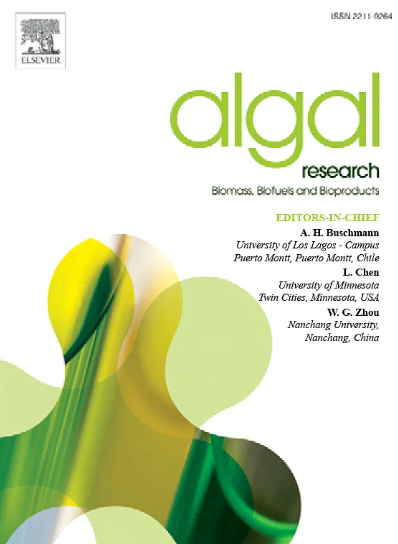Unveiling the potency of rice field cyanobacterial strains for plant growth promotion and root colonization by deciphering the molecular elicitors
IF 4.6
2区 生物学
Q1 BIOTECHNOLOGY & APPLIED MICROBIOLOGY
Algal Research-Biomass Biofuels and Bioproducts
Pub Date : 2025-06-09
DOI:10.1016/j.algal.2025.104131
引用次数: 0
Abstract
Soil cyanobacteria collected from paddy fields across six diverse locations were evaluated for their plant growth-promoting potential, specifically through cyanobacterial extracellular products (CEP) influencing Pisum sativum L. germination and subsequent morphometric traits. Out of 20 tested strains, Anabaena sp. MBDU 902 demonstrated radicle and plumule lengths of 4.59 cm and 1.75 cm, respectively, while Nostoc microscopicum MBDU 102 exhibited enhanced radicle and plumule growth responses of 60 % and 80 %. Strain prioritization was achieved through Preference Ranking Organization Method for Enrichment Evaluation (PROMETHEE) and Graphical Analysis for Interactive Assistance (GAIA), where Nostoc commune MBDU 101 emerged as the most potent strain based on aggregate growth metrics. The bioactive extract of Nostoc commune MBDU 101 was purified and analyzed using Preparative High-Performance Liquid Chromatography (P-HPLC) and Liquid Chromatography-Mass Spectrometry (LC-MS), identifying key phytohormones, including Indole-3-butyric acid (IBA), Gibberellic acid, IAA conjugates, and long chain fatty acids, confirmed via agar slant bioassay. To elucidate its root association capabilities, hydroponic cultivation of Zea mays L. was conducted using Nostoc commune MBDU 101 culture and CEP, resulting in significant enhancement of seedling length, biomass, leaf dimensions, and lateral root development compared to control. Root colonization was validated through confocal laser scanning microscopy (CLSM) and scanning electron microscopy (SEM). Gas Chromatography-Mass Spectrometry (GC–MS) revealed signaling molecules in culture filtrates essential for root association, underscoring Nostoc commune MBDU 101 robust plant growth-promoting attributes.
揭示水稻蓝藻菌株的效力,促进植物生长和根定植通过破译分子激发子
从六个不同地点的稻田中收集的土壤蓝藻对植物生长的促进潜力进行了评估,特别是通过蓝藻胞外产物(CEP)影响Pisum sativum L.萌发和随后的形态计量性状。在20个测试菌株中,Anabaena sp. MBDU 902的胚根和胚珠长度分别为4.59 cm和1.75 cm,而Nostoc microscopicum MBDU 102的胚根和胚珠生长速度分别提高了60%和80%。菌株优先级通过富集评价偏好排序组织方法(PROMETHEE)和交互式辅助图形分析(GAIA)来实现,其中Nostoc公社MBDU 101是基于总生长指标的最有效菌株。采用制备高效液相色谱法(P-HPLC)和液相色谱-质谱法(LC-MS)对Nostoc commune MBDU 101的生物活性提取物进行纯化和分析,通过琼脂倾斜生物试验鉴定出主要的植物激素,包括吲哚-3-丁酸(IBA)、赤霉素酸、IAA偶联物和长链脂肪酸。为了阐明其根系关联能力,采用Nostoc commune MBDU 101培养基和CEP对玉米进行水培,结果表明玉米幼苗长度、生物量、叶片尺寸和侧根发育均显著高于对照。通过共聚焦激光扫描显微镜(CLSM)和扫描电镜(SEM)验证了根定植。气相色谱-质谱分析(GC-MS)揭示了培养滤液中对根关联至关重要的信号分子,强调了Nostoc公社MBDU 101强大的植物生长促进属性。
本文章由计算机程序翻译,如有差异,请以英文原文为准。
求助全文
约1分钟内获得全文
求助全文
来源期刊

Algal Research-Biomass Biofuels and Bioproducts
BIOTECHNOLOGY & APPLIED MICROBIOLOGY-
CiteScore
9.40
自引率
7.80%
发文量
332
期刊介绍:
Algal Research is an international phycology journal covering all areas of emerging technologies in algae biology, biomass production, cultivation, harvesting, extraction, bioproducts, biorefinery, engineering, and econometrics. Algae is defined to include cyanobacteria, microalgae, and protists and symbionts of interest in biotechnology. The journal publishes original research and reviews for the following scope: algal biology, including but not exclusive to: phylogeny, biodiversity, molecular traits, metabolic regulation, and genetic engineering, algal cultivation, e.g. phototrophic systems, heterotrophic systems, and mixotrophic systems, algal harvesting and extraction systems, biotechnology to convert algal biomass and components into biofuels and bioproducts, e.g., nutraceuticals, pharmaceuticals, animal feed, plastics, etc. algal products and their economic assessment
 求助内容:
求助内容: 应助结果提醒方式:
应助结果提醒方式:


